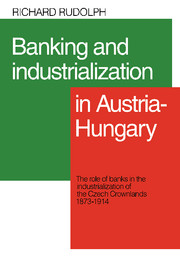 Banking and Industrialization in Austria-Hungary
Banking and Industrialization in Austria-Hungary Book contents
- Frontmatter
- Contents
- List of tables and charts
- Preface
- Abbreviations
- Introduction
- 1 Industrial development in the Austro-Hungarian Monarchy 1873–1914
- 2 Industrialization in the Czech Lands
- 3 Evolution of the financial structure
- 4 The relationship of banks to industry: the Viennese Great Banks
- 5 The relationship of banks to industry: the Czech banks
- 6 Sources of industrial credit
- 7 The role of the banks
- Appendixes
- Notes
- Select bibliography
- Index
5 - The relationship of banks to industry: the Czech banks
Published online by Cambridge University Press: 05 January 2012
- Frontmatter
- Contents
- List of tables and charts
- Preface
- Abbreviations
- Introduction
- 1 Industrial development in the Austro-Hungarian Monarchy 1873–1914
- 2 Industrialization in the Czech Lands
- 3 Evolution of the financial structure
- 4 The relationship of banks to industry: the Viennese Great Banks
- 5 The relationship of banks to industry: the Czech banks
- 6 Sources of industrial credit
- 7 The role of the banks
- Appendixes
- Notes
- Select bibliography
- Index
Summary
The periodization of changes in bank–industry relationships described in the preceding chapter applies almost equally well for both the Vienna centered banks and those with seats in the Czech Lands. There were some important distinctions, however, chiefly with regard to the linking of the Czech banks with the Czech nationalist upsurge in the latter part of the century.
Czech banking to the 1890s
The members of the Czech business community had every intention of utilizing the ZŽivnobanka to expand the voice of the Czech people in the commercial and industrial life of the country. The ZŽivnobanka, as well as all of the other Czech banks, made certain to include provisions for industrial promotion in their statutes; discussions at the time were replete with mention of the brothers Pereire and creédit-mobilier banking. The idea was favored by many that the small savings of the numerous Czechs, primarily engaged in agriculture, should be gathered in Prague and be used to promote Czech industrial enterprise. The time for this seemed particularly ripe in the 1860s and 1870s when the Czechs had at last entered into the production of spirits, beer, and sugar. Numerous small sugar factories and sugar refineries arose on the lands of the medium size farms of Bohemia, and a new phase in the life of the nationalist-minded Czechs seemed in the offing.
In the light of the avowed intent of developing investment banking, it is all the more interesting to note the degree to which the Czech banks failed to live up to their promise. From the very beginning, the directors of the Czech banks argued over the feasibility of such high-risk banking, and the debate continued for many years.
- Type
- Chapter
- Information
- Banking and Industrialization in Austria-HungaryThe Role of Banks in the Industrialization of the Czech Crownlands, 1873–1914, pp. 122 - 155Publisher: Cambridge University PressPrint publication year: 1976
